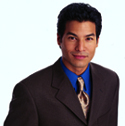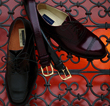|
|
 |
 |
| Dress for Success |
| |
| |
|
Our experts offer no nonsense advice for
buying, wearing, and caring for your new suit. We
pay special attention to dressing for a job
interview and making a good first impression.
Cutting edge industries and emerging fields have
brought a new spirit of creativity to the
workplace, and the suit has changed right along
with the rest of the business world. The rules
have changed, but the game is the same. We'll help
you play to win. |
THE FOUNDATION: SUITS
- Your first interview suit depends in large
part on the type of job for which you're
interviewing, but charcoal gray and navy blue
are always appropriate. Whether pinstriped,
plaid, solid, or herringbone, these colors
always represent a professional look and are
ideal for more conservative fields like
accounting, law, and medicine. Two-button,
vented, and softer shoulder garments in medium
to dark tones are ideal for these types of
interviews.
|
 |
- If you're interviewing for a position in
marketing, advertising, high-tech, service
industries and other more creative or casual
fields, you can go with the above options or
with a more fashion-forward suit, such as three-
or four-button models in earth tones or possibly
even black. Add houndstooth and more textured
fabrics in lighter to medium tones to the above
options, as well as non-vented jackets with
extended shoulders. Here's a general rule of
thumb: the more creative the work environment,
the more creative your options for the color and
style of your attire.
|
 |
- Look for suits made of 100% "worsted" wool.
The worsting process involves selecting long
wool fibers and twisting them into tight and
resilient yarns. Worsted wool yarns create year
round, wrinkle resistant and durable fabrics.
Wool is a natural fiber that breathes, which
means you'll be more comfortable, you'll
perspire less, and the fabric will travel well.
|
- Look for suit jackets that are fully lined
and pants that are lined to the knee. Lining
increases comfort and reduces wrinkling.
|
- Adding a crotch liner to your suit pants
will reduce the abrasion between your thighs and
the fabric. Crotch liners help your pants last
longer.
|
- A single-breasted suit is appropriate for
all fields of employment. Single-breasted
jackets come in a variety of styles, including
the classic two-button and modern three- and
four-button styles. Always leave the bottom
button on a single-breasted jacket undone.
|
 |
- When wearing a single-breasted suit with
more than two buttons, you may button just the
top, just the middle or all of the
buttons—except, of course, the bottom button.
|
- You may prefer a double-breasted suit for
your interviews. They usually have two columns
of visible buttons on the front of the jacket
and one hidden anchor button inside of
the overlap. Always button the anchor button so
that the right and left sides of the jacket hang
evenly. This takes practice.
|
- Most suits come with pants that are either
double- or triple-pleated. Whether you go with a
cuffed or plain hem is a matter of personal
preference. The weight of a cuff helps pleats to
hang smoothly and gives the pants a stylish
drape. Suit trousers fit differently than jeans
and casual pants. They should feel fuller
through the thigh and should be worn at your
waist, not on your
hips.
|
SUIT CARE
- Jacket pockets are sewn shut to prevent the
wearer from using them and potentially
disfiguring the drape of the jacket. However,
should you choose to have open and functional
pockets, just ask your Wardrobe Consultant or
Master Tailor to remove the tack stitching.
|
- Always use curved hangers for your suits,
with the curve going forward, and leave space
between garments in your closet. Cedar hangers
will absorb moisture, retain the shape of your
jacket, and repel moths.
|
- When sitting, pull your slacks up at the
thigh to reduce stress on the fabric and seams.
Make sure to pull up your socks; no skin should
show when you cross your legs.
|
- Always unbutton your suit coat when sitting;
when you're in a car, make sure you hang it up
rather than wear it.
|
- If you must put your garment bag in
an overhead bin when flying, wait until others
have put their items in first, and lay yours on
top.
|
- Of course, there will be times your suit
will get wrinkled. Men's Wearhouse will press
your suit free of charge - forever – at any
location. This not only saves you money on dry
cleaning, it also increases the life of your
suit.
|
- FYI: You only need to dry clean your suit
when it is dirty. Suits worn regularly usually
only need to be dry cleaned a few times per
year. Natural fibers become brittle when dry
cleaned too often, and brittle fibers break. So
if your suit's just wrinkled - but not soiled -
have it pressed. It'll last much
longer!
|
DON'T BUY SIZE…BUY
FIT.
- No matter how beautiful or costly your suit,
if it doesn't fit well, you're not going to look
good. That's why we have Master Tailors in every
store that will customize your fit.
|
- First rule: your suit should feel
comfortable. Take a few deep breaths and
relax. Take a stroll around the store and
practice shaking hands in your suit.
|
- The jacket collar should closely follow the
silhouette of the neck - with no gaping.
|
- Your suit jacket should lie smoothly over
your shoulders and across your back.
|
- The length of your suit jacket should be
long enough to cover up your entire seat and
look proportional to your physique.
|
- Your jacket sleeves should fall just at or
below the break of your wrists. A traditional
look is to show 1/4 to 1/2 inch of shirt cuff
below your jacket sleeve, but it is really a
matter of personal preference.
|
- The waist of your trousers should be just at
or slightly below your navel and should fit
snugly without feeling tight. A standard suit
waist size is generally six inches smaller than
a suit's jacket size. However, there are
different cuts created by suit manufacturers
such as European (smaller waist) or Executive
(larger waist). With our wide selection of
clothing and the expertise of our Master
Tailors, we can accommodate most any physique.
|
- If we've previously altered any seam on your
suit, Men's Wearhouse will re-alter that seam
free of charge if your weight
changes.
|
WHICH SHIRT ON YOUR
BACK?
- White shirts are best for your first
interview. Observe other employees' shirts
during your interview to judge the
appropriateness of other colors for your second
interview. When in doubt, wear white!
|
 |
- One hundred percent cotton works best for
shirts for the same reasons that wool works well
for suits: it breathes, so you perspire less and
feel more comfortable.
|
- A tee shirt worn underneath your dress shirt
gives you added protection against noticeable
perspiration and will help your shirt last
longer.
|
- Button tab collar and point collar shirts
work well with all styles of suits. Never wear a
button-down collar shirt with a double-breasted
suit. Tip: Ask your Wardrobe Consultant for free
collar stays for all of your point collar
shirts.
|
- Ask your dry cleaner to hang, rather than
box, your laundered shirts so that you won't
have to press them again later.
|
- A shirt should look as good, and fit as well
as your suit. It should be smooth around the
neck and allow for an index finger of breathing
room in the collar.
|
- There is no such thing as a short-sleeved
"dress" shirt. Always wear a long-sleeved dress
shirt to your interview and for all business
occasions.
|
CLOTHING MAY MAKE THE MAN,
BUT ACCESSORIES MAKE THE
CLOTHING.
- Your tie should make you appear businesslike
and complete a professional-looking package.
|
 |
- All of our ties are 100% silk, which assures
the best knot. They can also be dry cleaned.
|
- Refer to our animated How
To Tie A Tie tutorial to improve your
knotting techniques.
|
- Wear jewelry sparingly for your interviews.
In some settings, it may detract from your
professional appearance. Limit yourself to one
ring per hand, and leave earrings at
home.
|
- When coordinating colors, remember, leather
to leather and metal to metal. Always match the
color of your belt with your shoes and the color
of your belt buckle with your watch.
|
- If you're having trouble keeping your pants
at your waist, try braces. They look like
suspenders, but are less damaging to your slacks
because braces button inside of your waistband,
whereas suspenders clip onto your waistband.
|
- Never wear both braces and a belt!
|
- Here are some additional items to have handy
(in your car, perhaps): lint brush, extra
shoelaces, collar stays, mirror, fingernail
clippers with file, comb or a brush, and breath
mints.
|
THE SHOE MUST FIT!
- Comfort is key. If your feet hurt, you will
be miserable!
|
- Lace-up shoes look professional and work
especially well with suits. We suggest choosing
either wing tip, cap toe or split toe
styles.
|
- Black or burgundy shoes can be worn with
navy blue or gray suits for a professional
image.
|
 |
- Brown shoes are a wardrobe must, but are not
recommended for interviewing.
|
- Cedar shoetrees not only help keep the shape
of your shoes; they also absorb perspiration and
keep the leather supple.
|
- Be sure your shoes are shined, that the
edging is not fading (a magic marker can
sometimes work wonders,) and that laces are not
broken or frayed.
|
- You can remove water stains from leather
shoes with a bit of leather lotion on a clean
cloth.
|
- If your shoes have any loose thread, don't
pull or cut them -- use a match or lighter to
burn them off. Be sure to take your shoes off
before doing this, and be careful not to burn
the leather.
|
- Never wear a penny loafer or a casual loafer
with a suit.
|
- When trying on new shoes, they may feel
slightly stiff. Leather often needs time and
body heat to conform to your feet, so allow
about 6-8 hours of "break-in" time before your
interview. Tip: If you wear shoe inserts, bring
them to the store to insure a proper
fit.
|
|
It's very likely that your first interview will
be followed by a second, so be prepared by having
at least two suits with a different shirt and tie
combination for each one. A budget savvy option is
to buy a navy blazer and slacks for a second
interview. This will add versatility to your
wardrobe and give you a different look for your
second or additional interviews. You'll also find
that a navy blazer is the centerpiece of your
sport coat wardrobe. |
|
Although we can't guarantee you'll get that job
or land that account, we will guarantee
that we'll help you dress for success and that
you're going to like the way you
look! | |
| |
| |
|
|
| |
| |
 |
| |
